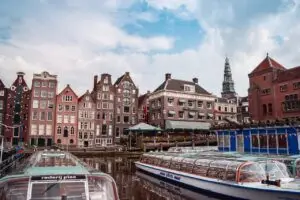Nestled along Spain’s sun-drenched Costa del Sol, Marbella effortlessly blends old-world Andalusian charm with contemporary Mediterranean glamour. Whether you’re seeking historic cobblestone streets, pristine beaches, world-class dining, or vibrant nightlife, this coastal gem offers an unforgettable escape for every type of traveler.
TL;DR: Top Things to Do in Marbella with Google Maps Links
- Explore Old Town & Plaza de los Naranjos
- Relax on Playa de Venus or Playa de la Fontanilla
- Visit Puerto Banús Marina
- Walk Avenida del Mar & see Dalí sculptures
- Hike La Concha Mountain
- Chill at Ocean Club, Nikki Beach, or Trocadero Playa
- Visit Ralli Museum
- Step into Iglesia de la Encarnación
- Discover local tapas & wine spots
- Take a day trip to Mijas Pueblo or Ronda
- Stroll the Paseo Marítimo promenade
- Golf at Los Naranjos or Aloha Golf Club
Why Visit Marbella Today
Marbella has evolved from a quiet fishing village into one of Europe’s most sophisticated resort destinations, yet it has managed to preserve its authentic Andalusian soul. This unique duality makes it a compelling destination in 2025.
Marbella’s Unique Mix of Luxury and History
The contrast between Marbella’s historic Casco Antiguo and the glittering Golden Mile creates a destination that appeals to both culture enthusiasts and luxury seekers. Within minutes, you can transition from browsing Renaissance-era churches to sipping champagne at exclusive beach clubs. The town’s 16th-century architecture sits harmoniously alongside modern marinas, creating an atmosphere that feels both timeless and contemporary.
Mediterranean Weather and Relaxed Lifestyle
With over 320 days of sunshine annually and average temperatures hovering around 18°C (64°F), Marbella offers nearly year-round pleasant weather. The Mediterranean climate encourages an outdoor lifestyle where long lunches, beach days, and evening paseos are part of daily life. This relaxed rhythm allows visitors to truly unwind and embrace the Spanish concept of “vivir despacio” (living slowly).
Ideal for Beach Holidays, Weddings, and Weekend Escapes
Marbella’s versatility makes it perfect for various occasions. Couples flock here for destination weddings against stunning Mediterranean backdrops, families appreciate the safe beaches and kid-friendly attractions, and groups of friends enjoy the vibrant social scene. The compact size means you can experience multiple facets of Marbella in a single long weekend.
Best Time to Visit Marbella
- Peak Season (June-August): Warmest weather, buzzing beach clubs, and full calendar of events, but also the most crowded and expensive
- Shoulder Season (April-May, September-October): Ideal balance of pleasant weather, fewer crowds, and lower prices; perfect for sightseeing and outdoor activities
- Winter (November-March): Mild temperatures (15-18°C/59-64°F), quieter atmosphere, and best deals on accommodation; excellent for golfing and exploring without summer heat
Must-See Attractions in Marbella
1. Marbella Old Town (Casco Antiguo)
The heart and soul of Marbella beats strongest in its enchanting Old Town. This beautifully preserved historic quarter transports visitors back centuries with its whitewashed buildings, geranium-filled balconies, and labyrinthine cobblestone streets.
Plaza de los Naranjos (Orange Square) serves as the Old Town’s social hub. Established in 1485 after the Christian Reconquest, this charming plaza is lined with orange trees and surrounded by outdoor cafés perfect for people-watching over coffee or tapas. The 16th-century Town Hall and Casa del Corregidor add architectural grandeur to the square.
Wander deeper into the narrow alleyways to discover hidden plazas, artisan boutiques, and family-run restaurants. Don’t miss the picturesque streets around Calle Remedios and Calle Ancha, where traditional Spanish tiles and wrought-iron details adorn nearly every doorway.
For authentic local dining, seek out traditional spots that have been serving locals for generations. The intimate atmosphere of these Old Town eateries provides an authentic taste of Andalusian cuisine away from tourist crowds.
Practical Tips:
- Best visited in early morning or evening to avoid midday heat
- Wear comfortable walking shoes for cobblestone streets
- Allow 2-3 hours for leisurely exploration
- Free to explore
2. Playa de Venus and Playa de la Fontanilla
Marbella boasts 27 kilometers of coastline with 24 distinct beaches, but Playa de Venus and Playa de la Fontanilla stand out as two of the most accessible and well-maintained options in the town center.
Playa de Venus offers a more local, relaxed vibe with soft golden sand and calm Mediterranean waters. Located just steps from the Old Town, this beach is perfect for families and those seeking a quieter spot. The beach provides basic amenities including showers, sunbed rentals, and several chiringuitos (beach bars) serving fresh seafood.
Playa de la Fontanilla, slightly larger and more centrally located, attracts a mix of tourists and locals. The palm-lined promenade behind the beach offers plenty of cafés and restaurants. Both beaches have earned Blue Flag certification for cleanliness and environmental standards.
Beach Essentials:
- Sunbed and umbrella rental: approximately €15-25 per day
- Peak beach hours: 11am-4pm (arrive early for best spots)
- Watersports available: jet skiing, paddleboarding, parasailing
- Lifeguards on duty during summer season
3. Puerto Banús Marina
Just 8 kilometers southwest of Marbella lies Puerto Banús, the epitome of Costa del Sol glamour. This world-famous marina, opened in 1970, has become synonymous with luxury yachts, designer shopping, and celebrity sightings.
Stroll along the waterfront to admire multi-million-euro superyachts and watch the sunset paint the harbor in golden hues. The marina’s distinctive whitewashed architecture creates a stunning backdrop for the gleaming vessels docked in its waters.
Shopping and Dining at Puerto Banús caters to high-end tastes. The marina area features flagship stores from Louis Vuitton, Gucci, Dior, and other luxury brands. El Corte Inglés department store offers a more varied shopping experience. For dining, choose from waterfront restaurants serving everything from fresh seafood to international cuisine—though expect premium prices matching the premium location.
Nightlife comes alive after dark when Puerto Banús transforms into one of the Costa del Sol’s premier party destinations. Exclusive nightclubs like Olivia Valere and Tibu attract international DJs and well-heeled crowds.
Getting There:
- Taxi from Marbella center: approximately €15-20
- Bus L1 runs frequently between Marbella and Puerto Banús (€1.50)
- Free parking can be challenging; paid parking available
4. Avenida del Mar
Connecting Marbella’s Old Town to the beachfront, Avenida del Mar is both an attraction and a functional thoroughfare. This tree-lined pedestrian avenue showcases ten bronze sculptures by Salvador Dalí, creating an open-air art gallery beneath swaying palms.
The surrealist sculptures were installed in the 1990s and include recognizable Dalí motifs like melting clocks and elongated figures. The avenue provides a pleasant 10-15 minute walk between the historic center and the sea, with benches perfect for rest stops and photo opportunities.
Street performers often entertain along the avenue during peak season, adding to the lively Mediterranean atmosphere. Small kiosks sell refreshments, souvenirs, and local crafts.
Best for:
- Photography enthusiasts
- Art lovers
- Leisurely strolls between beach and town
- Free activity suitable for all ages
5. La Concha Mountain Hike
For outdoor enthusiasts and those seeking stunning vistas, hiking La Concha (The Shell) offers Marbella’s most rewarding adventure. Rising 1,215 meters above sea level, this iconic mountain dominates Marbella’s skyline and provides breathtaking panoramic views of the Mediterranean coastline and surrounding Sierra Blanca range.
The Hike: The most popular trail begins in Ojén, a nearby village, and takes approximately 3-4 hours to reach the summit (one way). The route is well-marked but challenging, with steep sections requiring good fitness levels. The trail passes through pine forests and rocky terrain before emerging above the tree line for the final ascent.
On clear days, the summit rewards hikers with views stretching to Gibraltar and across to North Africa. The sense of accomplishment and the dramatic landscape make this one of Marbella’s most memorable experiences.
Essential Information:
- Difficulty: Moderate to challenging
- Best seasons: Spring and autumn (avoid summer heat)
- Start early: Begin at dawn to avoid afternoon sun
- Bring: Plenty of water (2-3 liters), sun protection, proper hiking boots
- Alternative: Shorter trails available on lower slopes for less experienced hikers
Safety Note: Always check weather conditions before attempting this hike, and consider hiring a local guide for your first ascent.
6. Marbella Beach Clubs
Beach clubs represent the quintessential Marbella experience, where Mediterranean sunshine meets sophisticated luxury. These venues combine restaurant, bar, pool, and beach access into carefully curated daytime experiences.
Nikki Beach Marbella: Located at the Don Carlos Hotel in Elviria, Nikki Beach pioneered the luxury beach club concept in Marbella when it opened in 2003. Known for white-draped cabanas, champagne service, and afternoon DJ sessions, it epitomizes barefoot luxury. Expect to spend €50-100+ per person for the experience including drinks and food.
Ocean Club Marbella: Situated in Puerto Banús, this 9,000-square-meter venue defines glamorous indulgence. With multiple pools, Balinese beds, and impeccable service, Ocean Club attracts an international crowd seeking upscale beach experiences. The venue often hosts special events and themed parties throughout summer.
Trocadero Playa: For a more traditional yet still stylish option, Trocadero Playa on the Golden Mile offers the original Marbella beach club experience. Its old-school chiringuito atmosphere features heavy wooden furniture amid palm trees, creating a relaxed yet refined ambiance.
Beach Club Tips:
- Reservations essential during peak season (book days in advance)
- Minimum spend requirements common for beach beds (€40-200+ depending on club and season)
- Dress codes typically “beach chic” (smart casual)
- Most clubs open April-October only
7. Ralli Museum
Art enthusiasts shouldn’t miss the Ralli Museum, a hidden gem showcasing contemporary Latin American and European art. This privately owned museum offers free admission and houses an impressive collection including works by Salvador Dalí, Diego Rivera, and Rufino Tamayo.
The museum’s architecture itself deserves attention, with its elegant galleries designed to optimize natural light. The collection focuses primarily on 20th and 21st-century figurative art, providing a counterpoint to modern abstract movements.
Rotating exhibitions ensure repeat visitors always discover something new, while the permanent collection includes outstanding examples of surrealism and expressionism.
Visitor Information:
- Admission: FREE
- Hours: Tuesday-Saturday, 10am-3pm (closed Sundays and Mondays)
- Location: Urb. Coral Beach, Ctra. de Cádiz km 176
- Duration: Allow 1-2 hours
- Perfect rainy-day activity
8. Iglesia de la Encarnación
The Church of the Incarnation stands as Marbella’s most important religious monument and architectural treasure. Built in the 17th century on the site of a former mosque, this Baroque church anchors Plaza de los Naranjos in the Old Town.
The church’s distinctive reddish-brown facade and ornate bell tower make it instantly recognizable. Inside, visitors can admire baroque altarpieces, religious artworks, and the impressive main altar. The church remains an active parish, so respectful behavior and appropriate dress are required (shoulders and knees covered).
During Semana Santa (Holy Week), the church becomes the focal point for Marbella’s elaborate religious processions, offering visitors a glimpse into deep-rooted Spanish Catholic traditions.
Visit Details:
- Admission: Free (donations appreciated)
- Open for viewing outside of mass times
- Best photographed from Plaza de los Naranjos
- 15-20 minute visit typical
9. Tapas and Wine Tasting
No Marbella visit is complete without embracing the Spanish tradition of tapas—small plates designed for sharing and socializing. The Old Town and surrounding neighborhoods offer countless opportunities to taste authentic Andalusian cuisine paired with excellent Spanish wines.
Classic Tapas to Try:
- Gambas al pil pil (garlic prawns)
- Jamón ibérico (cured ham from acorn-fed pigs)
- Boquerones en vinagre (marinated anchovies)
- Patatas bravas (spicy potatoes)
- Tortilla española (Spanish omelette)
- Berenjenas con miel (fried eggplant with honey)
The Tapas Experience: Rather than settling in one location, embrace the Spanish tradition of “ir de tapas”—hopping between several bars, ordering 1-2 dishes and drinks at each stop. This allows you to sample variety while experiencing different atmospheres.
Look for establishments filled with locals rather than tourist traps near major attractions. Traditional bars often display tapas under glass at the counter, allowing you to point and order without language barriers.
Wine Pairing: Andalusia’s sherries complement tapas beautifully, but don’t overlook excellent Spanish reds from Rioja or whites from Rías Baixas. Many bars offer wine flights allowing you to sample several varieties.
Budget Expectation: Plan €20-35 per person for a satisfying tapas evening including 4-6 dishes and wine.
10. Day Trip to Mijas Pueblo or Ronda
Marbella’s central location makes it an ideal base for exploring other spectacular Andalusian destinations.
Mijas Pueblo (30 minutes away): This charming white village perches in the hills above the coast, offering stunning Mediterranean views and traditional Spanish atmosphere. Wander narrow streets lined with whitewashed houses adorned with colorful flower pots, browse artisan shops, and visit the miniature museum collection. Don’t miss the unique plaza de toros (bullring) and the opportunity to photograph the famous “donkey taxis.”
Ronda (1 hour away): For a more dramatic day trip, Ronda delivers spectacular mountain scenery and historic intrigue. The town’s iconic Puente Nuevo bridge spans a 120-meter gorge, creating one of Spain’s most photographed landmarks. Explore one of Spain’s oldest bullrings, wander the atmospheric old town, and learn about Ronda’s role in Spain’s bandit legends. Wine enthusiasts can visit nearby bodegas in the Ronda wine region.
Day Trip Logistics:
- Car rental offers most flexibility for exploring
- Bus services available from Marbella bus station (Estación de Autobuses)
- Organized tours available through local operators
- Allow full day (6-8 hours) for proper exploration
11. Paseo Marítimo
Stretching approximately 10 kilometers along Marbella’s coastline, the Paseo Marítimo (maritime promenade) offers one of the most pleasant ways to experience the town’s beachfront. This palm-lined walkway connects various beaches and provides access to countless chiringuitos, restaurants, and cafés.
The promenade accommodates walkers, joggers, and cyclists, making it popular with both visitors and health-conscious locals. Morning and evening hours see particularly high activity as residents take their daily constitutional.
Along the route, you’ll pass children’s playgrounds, workout equipment, and strategically placed benches perfect for watching the Mediterranean waves. Street vendors occasionally set up stalls selling jewelry, sunglasses, and souvenirs.
Promenade Highlights:
- Watch sunrise or sunset over the Mediterranean
- Stop at chiringuitos for fresh grilled sardines
- People-watch from seafront cafés
- Connect to multiple beaches along the route
- Free activity suitable for all fitness levels
Pro Tip: Rent a bicycle to cover more distance and explore further reaches of the promenade beyond the central tourist areas.
12. Golfing in Marbella
Marbella and its surrounding Costa del Sol region have earned the nickname “Costa del Golf” thanks to over 50 world-class golf courses within easy reach. The combination of year-round sunshine, stunning scenery, and championship-standard facilities makes this one of Europe’s premier golf destinations.
Top Courses:
Los Naranjos Golf Club: Designed by Robert Trent Jones Sr., this course in Nueva Andalucía features mature orange and olive trees, water hazards, and mountain backdrops. The challenging layout rewards strategic play.
Aloha Golf Club: Another Nueva Andalucía gem, Aloha’s undulating fairways and large greens demand accuracy. The course integrates natural terrain features beautifully.
Real Club de Golf Las Brisas: Considered one of Europe’s finest courses, Las Brisas hosted multiple Spanish Opens. Streams and lakes come into play on 11 holes.
Practical Information:
- Green fees: €80-250+ depending on course and season
- Advance booking recommended, especially March-June and September-October
- Club rental and lessons available at most courses
- Many hotels offer golf packages with preferential rates
- Dress codes apply (collared shirts, proper golf shoes)
Golf courses also feature excellent clubhouse restaurants, making them pleasant destinations even for non-golfing companions who can enjoy facilities while others play.
Free and Budget-Friendly Things to Do
Experiencing Marbella doesn’t require unlimited funds. Many of the town’s highlights cost nothing or very little, making it accessible for budget-conscious travelers.
Free Activities:
Explore the Old Town: Wandering Casco Antiguo’s charming streets, plazas, and architectural treasures costs nothing but provides hours of enjoyment. Bring your camera and get lost in the labyrinth of whitewashed alleys.
Stroll the Paseo Marítimo: The entire 10-kilometer beachfront promenade is free to enjoy. Walk, jog, or simply sit on benches watching waves and people.
Visit Ralli Museum: One of Marbella’s best art collections charges no admission, making it an exceptional free cultural experience.
Public Beaches: All beaches are free to access, though sunbed and umbrella rentals cost extra. Bring your own towel and enjoy the sand and sea without charge.
Avenida del Mar: Admire Salvador Dalí sculptures while walking between town and beach at no cost.
Budget Activities:
Local Markets: Saturday morning flea market in Puerto Banús offers bargains on everything from clothing to antiques. The experience of browsing is entertainment itself.
Municipal Buses: At just €1.50 per ride, buses connect Marbella to Puerto Banús, San Pedro, and surrounding areas affordably.
Tapas at Local Bars: While touristy restaurants charge premium prices, neighborhood bars frequented by locals offer excellent tapas for €2-5 per portion.
Sunset Viewpoints: Pack a picnic and head to various viewpoints for free entertainment as the sun sets over the Mediterranean. Popular spots include the Faro de Marbella (lighthouse) area and various points along the coastal hills.
Self-Guided Walking: Download free walking tour apps or follow online guides to explore Marbella independently without tour costs.
Budget Tips:
- Shop at local supermarkets rather than tourist shops
- Eat menú del día (daily menu) at lunch for 3 courses at €10-15
- Visit during shoulder season for lower accommodation costs
- Stay in areas like San Pedro for cheaper lodging with easy Marbella access
Marbella Travel Tips for First-Time Visitors
Transportation
Getting to Marbella
Málaga-Costa del Sol Airport (AGP), located 45 kilometers northeast, serves as the primary gateway. From the airport:
- Bus: Direct bus service (€7-10, 45-60 minutes)
- Taxi: Fixed rate around €60-70
- Private transfer: Pre-book for €50-80 depending on provider
- Car rental: Available at airport; useful for exploring wider region
Getting Around Marbella
- Walking: Central Marbella is very walkable; Old Town requires walking
- Local buses: Excellent coverage between Marbella, Puerto Banús, and San Pedro (€1.50 per ride)
- Taxis: Plentiful and affordable for short trips (€7-15)
- Uber/Cabify: Available but less common than traditional taxis
- Car rental: Recommended only for day trips; parking in central areas is difficult
- Bicycle rental: Great for exploring the promenade (€15-25 per day)
Where to Stay
Old Town (Casco Antiguo)
- Best for: Culture enthusiasts, couples, authentic atmosphere
- Pros: Historic charm, walkable, excellent restaurants
- Cons: Noisy at night, limited parking, narrow streets
Golden Mile
- Best for: Luxury seekers, beach lovers
- Pros: Beach access, prestigious hotels, close to Marbella & Puerto Banús
- Cons: Expensive, requires transport to Old Town
Puerto Banús
- Best for: Nightlife enthusiasts, luxury shoppers
- Pros: Vibrant, designer shops, yacht-watching
- Cons: Very expensive, crowded in peak season
San Pedro de Alcántara
- Best for: Budget travelers, families, local vibe
- Pros: Affordable, authentic Spanish town
- Cons: 15 min bus/taxi to Marbella center
Seasonal Tips & Reservations
Peak Season (July–August)
- Book hotels and restaurants 2-3 months in advance
- Beach club reservations essential
- Expect crowds and premium prices
- Evening breezes make heat manageable
Shoulder Season (April–June, Sept–Oct)
- Best value with pleasant weather
- Book 3-4 weeks ahead
- Some beach clubs on reduced schedules
- Ideal for outdoor activities
Off-Season (Nov–March)
- 40-60% discounts on accommodation
- Many beach clubs closed, restaurants open
- Reduced attraction hours
- Perfect for golf and crowd-free exploration
Dining Reservations
Popular restaurants in Old Town and upscale spots require reservations, especially weekends and peak season. Book 1-2 days ahead.
What to Pack
- Comfortable walking shoes (cobblestones)
- Sun protection (hat, sunglasses, sunscreen)
- Beach attire (swimsuit, cover-up, beach bag)
- Smart casual evening wear (dress codes apply)
- Light layers (cool evenings in shoulder season)
- Adapter for European outlets (Type C/F)
Money Matters
- Credit cards widely accepted; carry cash for small purchases
- ATMs available everywhere
- Tipping optional (5-10% appreciated)
- Upscale venues may have minimum spends
Language
English is common in tourist areas, but learning basic Spanish phrases enhances your experience and is appreciated by locals.
FAQs About Visiting Marbella
What not to miss in Marbella? Don’t leave without exploring the Old Town’s Plaza de los Naranjos, experiencing at least one beach club, strolling Puerto Banús marina, and sampling authentic tapas at a local bodega. The combination of historic atmosphere and modern luxury represents Marbella’s essence.
What is Marbella popular for? Marbella is renowned for its upscale beach clubs, luxury yacht marina at Puerto Banús, exceptional golf courses, beautiful beaches, and charming historic Old Town. The destination attracts affluent visitors seeking Mediterranean sunshine combined with sophisticated amenities.
What to do for a day in Marbella? Start with morning coffee in Plaza de los Naranjos, explore the Old Town’s historic streets, walk Avenida del Mar to the beach, enjoy lunch at a beachfront chiringuito, relax on Playa de la Fontanilla, and finish with sunset drinks at Puerto Banús followed by tapas in the Old Town.
Is it better to go to Málaga or Marbella? These destinations serve different purposes. Málaga offers more cultural attractions (Picasso Museum, historic cathedral, vibrant arts scene) and urban energy, while Marbella focuses on beaches, luxury, and relaxation. Many visitors combine both—stay in Marbella for beach and glamour, day-trip to Málaga for culture. Marbella suits beach holidays; Málaga suits city breaks.
Which month is best for Marbella? May, June, and September offer ideal conditions: warm weather (23-28°C/73-82°F), manageable crowds, and reasonable prices. July-August brings peak heat and crowds. October remains pleasant but some beach clubs close. April can be perfect but slightly cooler with occasional rain.
Does a train run from Málaga to Marbella? No direct train service exists between Málaga and Marbella. Options include bus (most economical at €7-10, 45-60 minutes), taxi (€60-70), or car rental. The bus is reliable and comfortable with multiple daily departures from Málaga bus station.
Why is Marbella famous? Marbella gained international fame in the 1950s-60s when European aristocracy and celebrities discovered its charms. The 1970 opening of Puerto Banús cemented its reputation as a luxury destination. Today it’s famous for combining historic Spanish character with upscale amenities, beautiful beaches, and world-class golf.
What is so special about Marbella? Marbella uniquely balances authenticity and luxury. The beautifully preserved Old Town maintains genuine Spanish character while the Golden Mile and Puerto Banús deliver international sophistication. This duality—along with exceptional weather, stunning scenery, and diverse activities—makes Marbella special.
What to do in Marbella for free? Explore the Old Town, walk the entire Paseo Marítimo, visit Ralli Museum, enjoy public beaches, admire Dalí sculptures on Avenida del Mar, attend free concerts in Plaza de los Naranjos (summer), watch sunset from various viewpoints, and browse Saturday markets.
Is Marbella a walkable city? The historic center and beachfront areas are highly walkable and pedestrian-friendly. However, Marbella sprawls considerably along the coast—distances between Old Town, Puerto Banús (8km west), and eastern beaches require buses, taxis, or cars. Within distinct areas, walking is pleasant and practical.
Why do Brits go to Marbella? British visitors have flocked to Marbella since the 1960s for reliable sunshine, direct flights from UK airports, English-speaking environment, golf courses, and affordable luxury compared to northern European destinations. The established expat community and familiar amenities create comfort while still offering Spanish culture.
Is Marbella good for families? Yes, Marbella suits families well. Beaches have calm waters and lifeguards, many restaurants welcome children, and attractions like Aventura Amazonia (adventure park) and various water parks cater to young visitors. However, the emphasis on nightlife and beach clubs means some areas are more adult-oriented—families should choose accommodation accordingly.
Is Marbella expensive? Marbella ranges from moderate to expensive depending on choices. Beach clubs, Puerto Banús restaurants, and Golden Mile hotels command premium prices. However, the Old Town offers affordable tapas bars, public beaches cost nothing, and san Pedro provides budget accommodation. Overall, expect to pay 20-40% more than average Spanish destinations.
Is Marbella safe for tourists? Marbella is generally very safe with low violent crime rates. Petty theft (pickpocketing, bag snatching) can occur in crowded tourist areas, particularly beach promenades and Puerto Banús at night. Take standard precautions: watch belongings, avoid displaying expensive jewelry, and use hotel safes for valuables.
What airport do you fly into for Marbella? Málaga-Costa del Sol Airport (AGP) serves Marbella, located 45 kilometers away. This major international airport receives flights from throughout Europe and beyond. Gibraltar Airport (GIB) is an alternative for some visitors, located 80 kilometers southwest.
How many days do you need in Marbella? Three to five days allows thorough exploration without rushing. A weekend (2-3 days) covers highlights; a full week permits day trips to Ronda, Granada, or Seville while still enjoying leisurely beach time. The relaxed pace encourages longer stays—many visitors extend their trips after arriving.
Final Thoughts
Marbella masterfully blends the best of traditional Andalusia with contemporary Mediterranean luxury, creating a destination that rewards visitors with diverse interests. Whether you’re drawn to historic cobblestone plazas, golden beaches, world-class golf, vibrant nightlife, or simply the Spanish art of leisurely living, Marbella delivers memorable experiences against a backdrop of near-perfect weather and stunning coastal scenery.
The beauty of Marbella lies in its versatility—you can craft an ultra-luxurious escape or a budget-friendly beach holiday from the same base. You can spend mornings exploring centuries-old churches and afternoons sipping champagne at glamorous beach clubs. This flexibility, combined with excellent infrastructure and welcoming atmosphere, explains why visitors return year after year.
As you plan your Marbella adventure, remember that the town’s magic often reveals itself in unexpected moments: a hidden plaza discovered while wandering lost in the Old Town, spontaneous tapas with new friends at a neighborhood bar, or the simple pleasure of an early morning beach walk before the crowds arrive.
Ready to explore more of Costa del Sol and Spain?
Marbella serves as an excellent gateway to wider Andalusian exploration. Consider extending your journey to discover:
- Granada: Home to the magnificent Alhambra palace
- Seville: Andalusia’s passionate, flamenco-filled capital
- Córdoba: Where the stunning Mezquita showcases Spain’s multicultural heritage
- Nerja: Dramatic cliffs, caves, and quieter beaches east of Málaga
- Cádiz: Historic port city with authentic Spanish character
For more detailed guides to Costa del Sol destinations, Spanish travel tips, and insider recommendations, explore our collection of comprehensive travel resources. Whether you’re planning your first Spanish adventure or returning to discover new corners of this captivating country, there’s always more to uncover in sun-drenched southern Spain.
Start planning your Marbella escape today!





